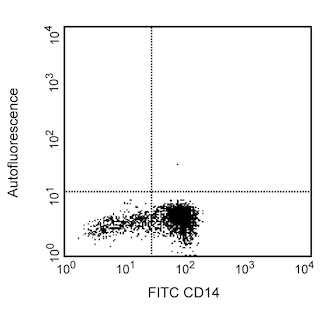-
Your selected country is
Middle East / Africa
- Change country/language
Old Browser
This page has been recently translated and is available in French now.
Looks like you're visiting us from {countryName}.
Would you like to stay on the current country site or be switched to your country?


.png)

Flow cytometric analysis of human disialoganglioside GD2 expression on human mesenchymal stem cells (MSCs) or M21 cell lines. Human mesenchymal stem cells (Lonza, Cat. No. PT-2501, left panel) or M21 cells (right panel) were stained with PE Mouse Anti-Human Disialoganglioside GD2 (Cat. No. 562100; solid line histogram) or with a PE Mouse IgG2a, κ Isotype Control (Cat. No. 555574/553457; dashed line histogram). The fluorescence histograms were derived from gated events with the forward and side light-scatter characteristics of viable cells. Flow cytometry was performed using a BD™ LSR II Flow Cytometry System.
.png)

BD Pharmingen™ PE Mouse Anti-Human Disialoganglioside GD2
.png)
Regulatory Status Legend
Any use of products other than the permitted use without the express written authorization of Becton, Dickinson and Company is strictly prohibited.
Preparation And Storage
Product Notices
- This reagent has been pre-diluted for use at the recommended Volume per Test. We typically use 1 × 10^6 cells in a 100-µl experimental sample (a test).
- Caution: Sodium azide yields highly toxic hydrazoic acid under acidic conditions. Dilute azide compounds in running water before discarding to avoid accumulation of potentially explosive deposits in plumbing.
- For fluorochrome spectra and suitable instrument settings, please refer to our Multicolor Flow Cytometry web page at www.bdbiosciences.com/colors.
- An isotype control should be used at the same concentration as the antibody of interest.
- Source of all serum proteins is from USDA inspected abattoirs located in the United States.
- Please refer to www.bdbiosciences.com/us/s/resources for technical protocols.
Companion Products



Gangliosides are sialic-acid bearing glycolipids that are expressed on the surface of all mammalian cells, and are likely involved in mediating cell-substratum interactions. They are important target antigens for antibody dependent cellular cytotoxicity (ADCC) of human melanoma and neuroblastoma cells. Human melanoma cells produce gangliosides, designated as GD2 and GD3 which are deposited in the subtratum-attached material, and may play a significant role in the melanoma metastatic phenotype. Clone 14.G2a specifically reacts with human and mouse GD2 ganglioside. LAN-1 human neuroblastoma cells were used as immunogen. Clone 14.G2a is an isotype switch variant selected from the parental IgG3-producing hybridoma 14.18 and has identical reactivity as the parental antibody. Clone 14.G2a is routinely tested by flow cytometry using M21 human melanoma cells.

Development References (9)
-
Cheresh DA, Honsik CJ, Staffileno LK, Jung G, Reisfeld RA. Disialoganglioside GD3 on human melanoma serves as a relevant target antigen for monoclonal antibody-mediated tumor cytolysis. Proc Natl Acad Sci U S A. 1985; 82(15):5155-5159. (Biology). View Reference
-
Cheresh DA, Klier FG. Disialoganglioside GD2 distributes preferentially into substrate-associated microprocesses on human melanoma cells during their attachment to fibronectin. J Cell Biol. 1986; 102(5):1887-1897. (Biology). View Reference
-
Cheresh DA, Pierschbacher MD, Herzig MA, Mujoo K. Disialogangliosides GD2 and GD3 are involved in the attachment of human melanoma and neuroblastoma cells to extracellular matrix proteins. J Cell Biol. 1986; 102(3):688-696. (Biology). View Reference
-
Cheresh DA, Rosenberg J, Mujoo K, Hirschowitz L, Reisfeld RA. Biosynthesis and expression of the disialoganglioside GD2, a relevant target antigen on small cell lung carcinoma for monoclonal antibody-mediated cytolysis. Cancer Res. 1986; 46(10):5112-5118. (Clone-specific: Immunofluorescence, Immunohistochemistry). View Reference
-
Frost JD, Hank JA, Reaman GH, et al. A phase I/IB trial of murine monoclonal anti-GD2 antibody 14.G2a plus interleukin-2 in children with refractory neuroblastoma: a report of the Children's Cancer Group. Cancer. 1997; 80(2):317-333. (Clone-specific: Cytotoxicity). View Reference
-
Hakomori S. Tumor-associated carbohydrate antigens. Annu Rev Immunol. 1984; 2:103-126. (Biology). View Reference
-
Lode HN, Reisfeld RA, Handgretinger R, Nicolaou KC, Gaedicke G, Wrasidlo W. Targeted therapy with a novel enediyene antibiotic calicheamicin theta(I)1 effectively suppresses growth and dissemination of liver metastases in a syngeneic model of murine neuroblastoma. Cancer Res. 1998; 58(14):2925-2928. (Clone-specific: Flow cytometry). View Reference
-
Mujoo K, Cheresh DA, Yang HM, Reisfeld RA. Disialoganglioside GD2 on human neuroblastoma cells: target antigen for monoclonal antibody-mediated cytolysis and suppression of tumor growth. Cancer Res. 1987; 47(4):1098-1104. (Clone-specific: Cytotoxicity, Inhibition). View Reference
-
Mujoo K, Kipps TJ, Yang HM, et al. Functional properties and effect on growth suppression of human neuroblastoma tumors by isotype switch variants of monoclonal antiganglioside GD2 antibody 14.18. Cancer Res. 1989; 49(11):2857-2861. (Clone-specific: Cytotoxicity). View Reference
Please refer to Support Documents for Quality Certificates
Global - Refer to manufacturer's instructions for use and related User Manuals and Technical data sheets before using this products as described
Comparisons, where applicable, are made against older BD Technology, manual methods or are general performance claims. Comparisons are not made against non-BD technologies, unless otherwise noted.
For Research Use Only. Not for use in diagnostic or therapeutic procedures.
Report a Site Issue
This form is intended to help us improve our website experience. For other support, please visit our Contact Us page.